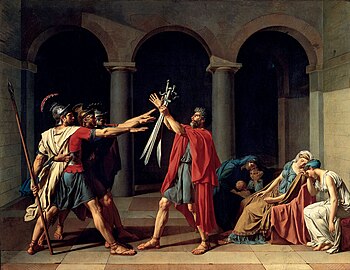
Back የኦራፂዮች ቃለ መሐላ Amharic قسم الإخوة هوراس Arabic قسم هوراتى ARZ Horatsilərin andı Azerbaijani Клетва на Хорациите Bulgarian El jurament dels Horacis Catalan Přísaha Horatiů Czech Horatiernes ed Danish Der Schwur der Horatier German Ο όρκος των Ορατίων (Ζακ-Λουί Νταβίντ) Greek
| Oath of the Horatii | |
|---|---|
 | |
| Artist | Jacques-Louis David |
| Year | 1784 |
| Medium | Oil on canvas |
| Dimensions | 329.8 cm × 424.8 cm (129.8 in × 167.2 in) |
| Location | Louvre, Paris |
Oath of the Horatii (French: Le Serment des Horaces) is a large painting by the French artist Jacques-Louis David painted in 1784 and 1785 and now on display in the Louvre in Paris.[1] The painting immediately became a huge success with critics and the public and remains one of the best-known paintings in the Neoclassical style.
It depicts a scene from a Roman legend about a seventh-century BC dispute between two warring cities, Rome and Alba Longa,[2] and stresses the importance of patriotism and masculine self-sacrifice for one's country. Instead of the two cities sending their armies to war, they agree to choose three men from each city; the victor in that fight will be the victorious city. From Rome, three brothers from a Roman family, the Horatii, agree to end the war by fighting three brothers from a family of Alba Longa, the Curiatii. The three brothers, all of whom appear willing to sacrifice their lives for the good of Rome,[1] are shown stretching their hands towards their father who holds their swords out of them.[3] Of the three Horatii brothers, only one will survive the confrontation. However, it is the surviving brother who is able to kill the other three fighters from Alba Longa: he allows the three fighters to chase him, causing them to separate from each other, and then, in turn, kills each Curiatii brother. Aside from the three brothers depicted, David also represents, in the bottom right corner, a woman crying while sitting down. She is Camilla, a sister of the Horatii brothers, who is also betrothed to one of the Curiatii fighters, and thus she weeps in the realisation that, whatever happens, she will lose someone she loves. Seeing her weep, the surviving brother, Publius, kills Camilla for weeping over the enemy.
The principal sources for the story behind David's Oath are the first book of Livy (sections 24–26) which was elaborated by Dionysius in book 3 of his Roman Antiquities.[4] However, the moment depicted in David's painting is his own invention.[5][6]
It grew to be considered a paragon of neoclassical art. The painting increased David's fame, allowing him to take on his own students.[7]
- ^ a b Ophélie Lerouge. "The Oath of the Horatii". Louvre. Retrieved 7 April 2019.
- ^ "Horatii and Curiatii". Encyclopaedia Britannica.
- ^ Roth, Michael (1994). "Facing the Patriarch in Early Davidian Painting". Rediscovering history: culture, politics, and the psyche. Stanford University Press. p. 308. ISBN 9780804723138.
- ^ Marvin, Roberta Montemorra; Downing A. Thomas (2006). "Roman Republicanism and Operatic Heroines". Operatic migrations: transforming works and crossing boundaries (illustrated ed.). Ashgate Publishing, Ltd. pp. 102–103. ISBN 9780754650980.
- ^ Winkler, Martin M. (2009). The Roman Salute: Cinema, History, Ideology. Columbus: Ohio State University Press. pp. 42–56. ISBN 9780814208649.
- ^ Cite error: The named reference
:0was invoked but never defined (see the help page). - ^ Jacques-Louis David: The Oath of the Horatii Archived 2016-05-01 at the Wayback Machine (from the Boston College website. Retrieved 2008-01-10.)